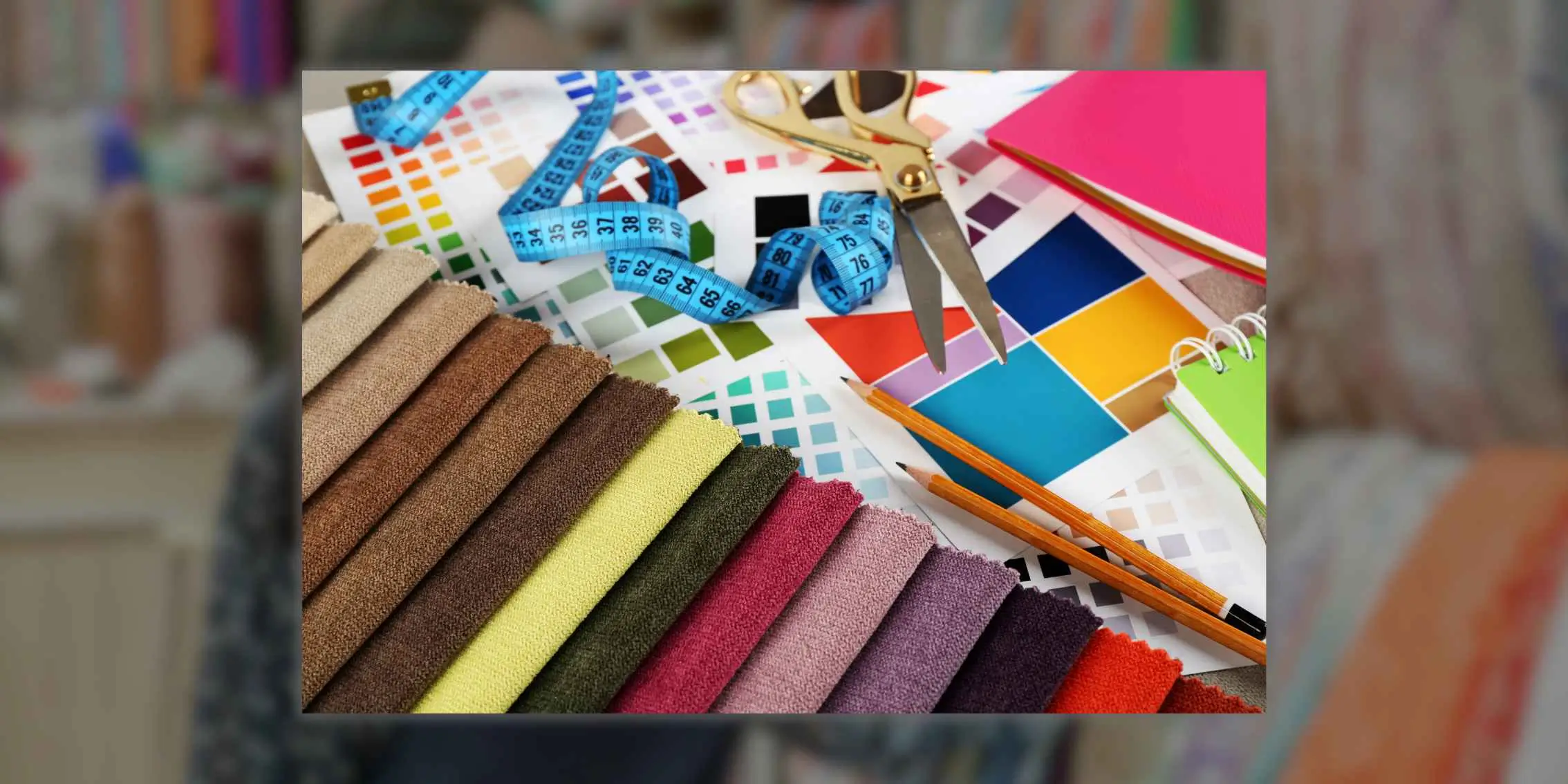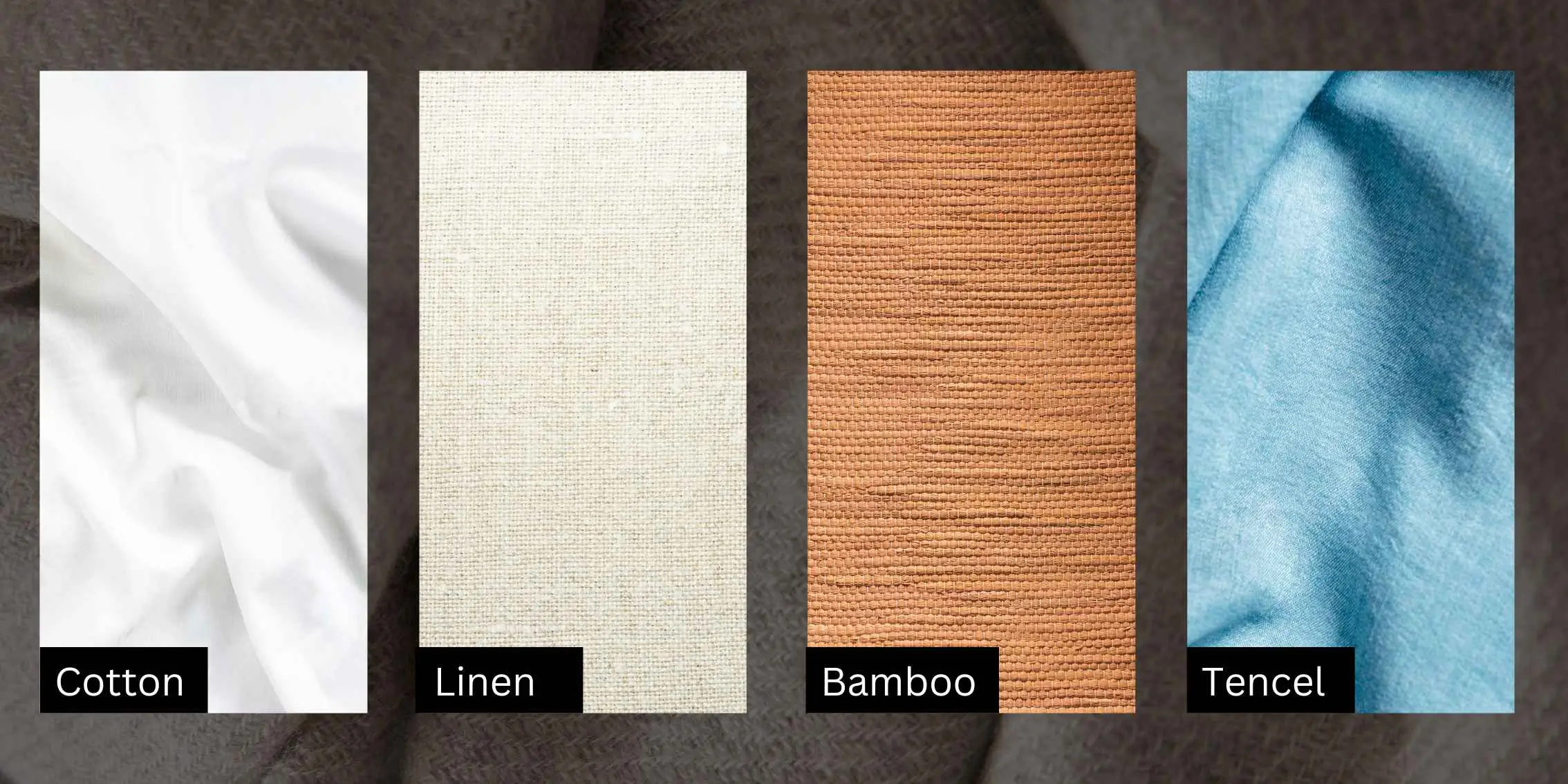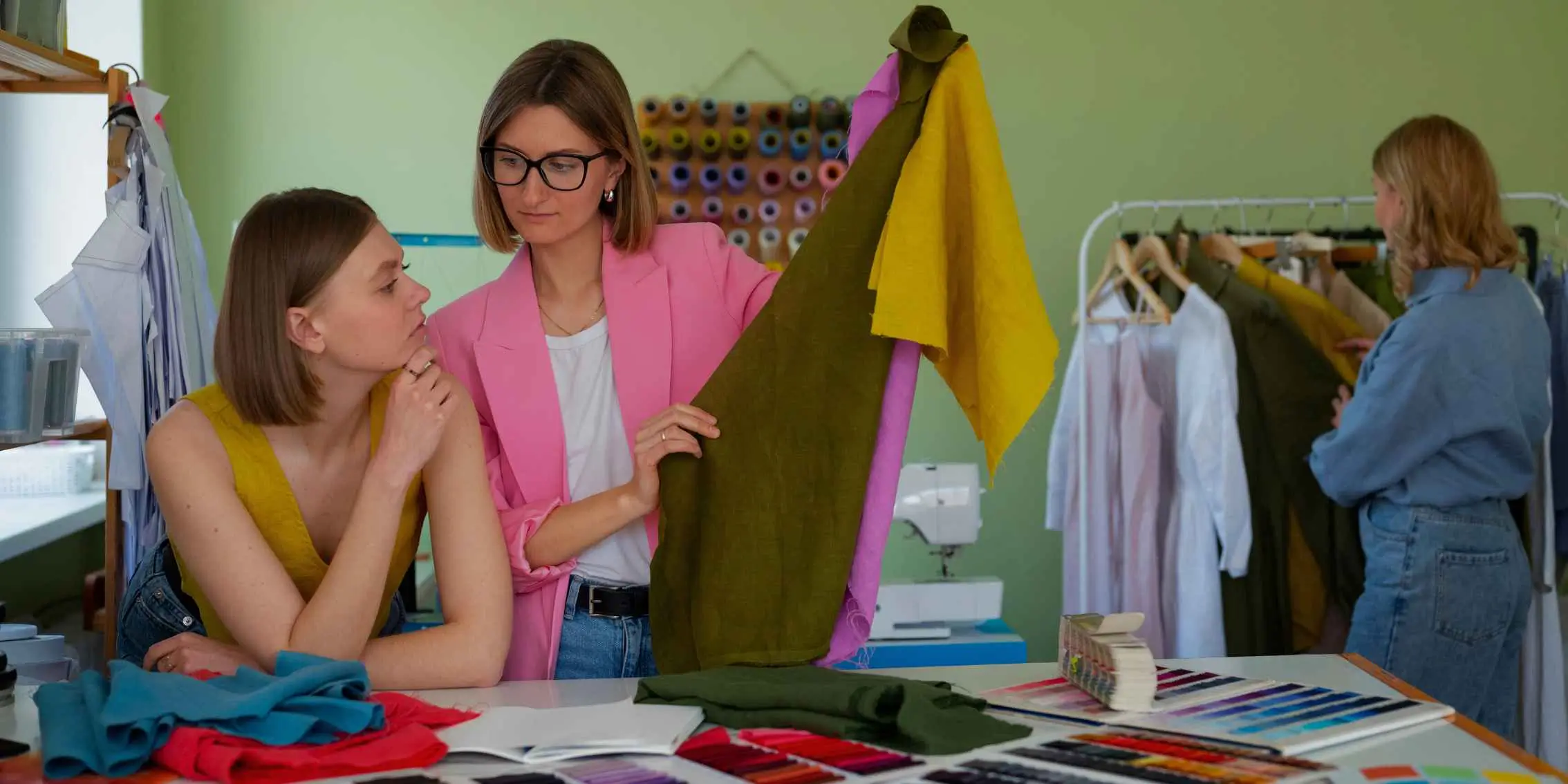Fabric Fundamentals: A Designer’s Guide to Textiles and Their
Properties
Fabric goes beyond just being the “material” for fashion—it’s the backbone of
every garment, setting the stage for shape, comfort, and aesthetic. As a
designer, knowing your textiles is critical to making sure your pieces look and
feel as you intended.
In this textile guide for designers, we’ll explore how
fibres become
fabric, why certain weaves work best for certain styles, and which properties
(like weight or drape) matter when you’re envisioning a new design. By the end,
you’ll have a solid foundation in fabric selection for garments, helping you
create pieces that don’t just look good on paper—but shine in real life, too.
 Image source: Canva
Image source: Canva
Why Fabric Knowledge Matters
Ever sketched the perfect piece, only to have the final version feel off, stiff,
or just not “right”? Often, that mismatch boils down to choosing the wrong
fabric. Whether it’s a breezy sundress that should flow but ends up stiff, or a
fitted blazer that fails to hold its shape, fabric choice can make or break your
design.
- Fit and Comfort: A drapey fabric contours differently from
a structured weave.
- Durability and Quality: Some
fibres handle
daily wear better than others.
- Creative Expression: Textiles add texture, sheen, or rustic
charm—whatever your design calls for.
Key Takeaway: From everyday basics to runway showpieces,
mastering textiles is a must for turning your creative ideas into garments
people love to wear.
Understanding Textiles: Fabric Construction
 Image source: Canva + Freepik
Image source: Canva + Freepik
Fibres vs.
Fabrics
- Fibres:
The raw building blocks (think cotton, wool, polyester).
- Fabrics: The “finished” textile made by weaving, knitting,
or bonding those
fibres
together.
Knowing each
fibres’s
characteristics—like breathability, warmth, or cost—gives you insight into how a
fabric will behave once it’s made into a garment.
Natural vs. Synthetic Fabrics
| Type
|
Examples
|
Pros
|
Cons
|
| Natural
|
Cotton, Linen, Silk, Wool
|
Breathable, biodegradable, comfortable
|
Can wrinkle, higher maintenance, sometimes pricier
|
| Synthetic
|
Polyester, Nylon, Spandex
|
Durable, cost-effective, often wrinkle-free
|
Less breathable, potential environmental impact
|
| Regenerated
|
Rayon, Lyocell (Tencel)
|
Soft drape, more eco-friendly than synthetics
|
Requires specific processing, availability varies
|
Most textiles today blend natural and synthetic
fibres for the
best of both worlds (comfort + durability).
Weaves & Knits: How Structure Influences Behavior
- Woven Fabrics: Less stretch, more structure. For
example:
- Plain Weave (like cotton poplin) for crisp shirts.
- Twill Weave (like denim) for tough, angled textures.
- Satin Weave for a glossy, elegant finish.
- Knitted Fabrics: More stretch, following the body’s curves.
Great for T-shirts, sportswear, and body-hugging dresses.
- Single Jersey: Common in everyday tees.
- Rib Knit: Perfect for cuffs, waistbands, fitted tops.
- Interlock Knit: Adds stability while retaining
stretch.
Key Fabric Types and Properties Every Designer Should Know
 Image source: Canva
Image source: Canva
Weight & Thickness
Measured in grams per square metre (gsm) or ounces per yard, fabric weight
affects how your design drapes, holds shape, or provides warmth.
- Lightweight: Chiffon, organza, perfect for ethereal, flowy
designs.
- Medium Weight: Cotton lawn, linen—versatile for casual
garments.
- Heavyweight: Denim, wool—adds structure, ideal for jackets
and jeans.
Drape & Flow
- Soft Drape: Silk, rayon, viscose—fall gently, creating
movement.
- Firm Drape: Taffeta, canvas—hold their shape, great for
volume or tailoring.
Breathability & Moisture Management
- Natural
fibres
(cotton, linen, wool) let air circulate, useful in warm or variable
climates.
- Moisture-Wicking Materials (like merino wool, performance
polyesters) draw sweat away from skin, ideal for activewear.
Stretch & Recovery
- Stretch Fabrics: Lycra/spandex blends in knits add
flexibility, hugging curves or facilitating movement.
- Recovery: The ability to return to original form after
stretching—key for leggings, bodycon dresses, and other fitted pieces.
Durability & Wear Resistance
- Denim, Canvas: Strong, withstand daily wear—classic for
jackets, jeans, bags.
- Silk, Lace: Delicate, stunning but need careful handling
(maybe not for daily rough-and-tumble).
Common Fabrics, Characteristics and Uses
Cotton & Linen
- Pros: Breathable, comfortable, generally easy to work
with.
- Cons: Can wrinkle or shrink, especially if not
pre-washed.
- Best For: Casual tops, summer dresses, relaxed pants, kids’
wear.
Silk & Satin
- Pros: Luxurious sheen, gentle drape, feels amazing on
skin.
- Cons: Prone to snags, often requires delicate washing or
dry cleaning.
- Best For: Evening gowns, blouses, lingerie, high-end
details.
Wool & Cashmere
- Pros: Great for insulation, shape retention, natural
odour
resistance.
- Cons: Can be itchy (depending on grade), may need special
care.
- Best For: Coats, suits, winter accessories, structured
dresses.
Polyester & Blends
- Pros: Affordable, wrinkle-resistant, strong.
- Cons: May lack breathability, can pill over time if lower
quality.
- Best For: Mass-market apparel, athletic wear (with
spandex), linings, and cost-effective designs.
Denim & Twill
- Pros: Durable, iconic texture, robust for daily wear.
- Cons: Stiffer initially, heavier on the body.
- Best For: Jeans, jackets, utilitarian or structured
looks.
Fabric Finishes & Treatments
Dyeing & Printing
Whether it’s a solid dye or an intricate digital print,
colour and
pattern greatly affect the mood and theme of your design. Consider how your
chosen fabric will accept dye—cotton absorbs
colours well,
whereas synthetics may require specialized dyes or printing processes.
Coatings & Treatments
- Waterproofing (e.g., waxed cotton, PU coatings) for
outerwear and rainwear.
- Stain-Resistance (e.g., Teflon coatings) popular for
uniforms or children’s wear.
- Wrinkle-Free: Common for corporate or travel-friendly
pieces.
Texture & Hand Feel
- Brushed Cotton: Adds softness, warmth.
- Mercerization (cotton): Improves shine and dye uptake.
- Suede, Velvet: Luxurious hand feel, but need careful
care.
Fashion Designer Fabric Guide: How to Choose the Right Fabric for Your
Design
Considering the Garment’s Purpose
- Casual & Daywear
- Lean on breathable, easy-care fabrics like cotton or poly-cotton
blends.
- Evening & Formal
- Aim for sheen (satins, silks) or rich textures (velvet, brocade).
- Active & Sportswear
- Focus on stretch, moisture-wicking (nylon-spandex, merino wool).
- Outerwear
- Prioritise
warmth and durability (wool, technical blends, coated fabrics).
Matching Fabric to Design Aesthetics & Functionality
- Structured Silhouettes: Medium-to-heavyweight wovens that
hold shape.
- Fluid, Flowing Looks: Soft, drapey textiles—chiffon,
georgette, or rayon.
- Bold Prints: Fabrics that take dye well (cotton, polyester
blends), ensuring vivid, long-lasting
colour.
Balancing Cost, Sustainability & Availability
- Budget: High-end silks and wools cost more but elevate
perceived garment value.
- Sustainability: Seek organic, recycled, or low-impact
manufacturing processes.
- Local Sourcing: Minimizes shipping costs, supports local
economies.
Pro Tip: Always request swatches before committing to bulk
orders. Feeling the fabric and testing its drape can confirm (or change) your
initial plan.
Sustainable & Ethical Fabric Choices
Eco-Friendly Textiles
 Image source: Canva
Image source: Canva
- Organic Cotton: Grown without harsh chemicals.
- Hemp & Linen: Less water usage, durable,
biodegradable.
- Bamboo & Tencel: Quick-growing, often produced with more
eco-conscious methods than standard rayon.
Fast Fashion vs. Slow Fashion
- Fast Fashion: Typically uses low-cost synthetics, mass
production, and shorter garment lifespans.
- Slow Fashion: Encourages better-quality materials, fair ,
labour and
designs intended to last multiple seasons.
Recycled & Upcycled
- Recycled Polyester (rPET): Converts plastic waste into new
yarn.
- Upcycled Denim: Breathe new life into leftover or vintage
jeans.
- Deadstock Fabrics:
Utilising
factory leftovers, reducing landfill waste.
Sustainability isn’t just a marketing angle—it’s increasingly expected by
consumers. Aligning with eco-friendlier practices can set you apart in a
competitive market.
Master Your Fabric Choices and Elevate Your Designs
Fabric can transform an idea from a simple sketch to a standout piece. By
understanding
fibres, weaves,
key properties, and finishing treatments, you’re better positioned to design
garments that meet your aesthetic goals and truly satisfy the wearer—whether
it’s comfort for casual looks, drama for eveningwear, or performance for active
apparel.
At The
Fashion Design Institute, we delve deeper into these textile fundamentals,
teaching you how to experiment with fabrics, master garment construction, and
develop an eye for sustainable sourcing. Our courses bridge both creative vision
and practical skills, helping you build a strong portfolio and a more confident
approach to design.
Take Your Fabric Knowledge Further
 Image source: Freepik
Image source: Freepik
Ready to integrate advanced textile expertise into your work? Enrol
in our comprehensive online course to explore Module 4: Textiles & Clothing
and beyond. Gain the industry insight you need to choose the perfect
fabrics—turning every creative spark into a garment that feels as good as it
looks.
 Image source: Canva
Image source: Canva
 Image source: Canva + Freepik
Image source: Canva + Freepik
 Image source: Canva
Image source: Canva
 Image source: Canva
Image source: Canva
 Image source: Freepik
Image source: Freepik